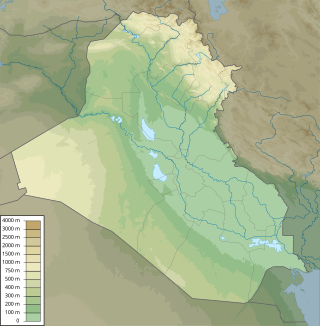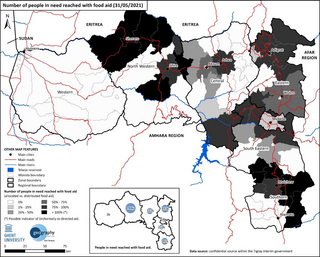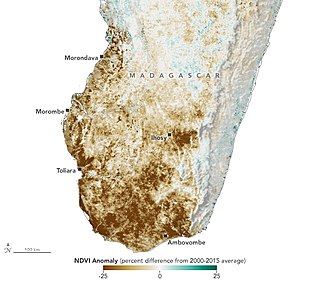
A drought is a period of drier-than-normal conditions. A drought can last for days, months or years. Drought often has large impacts on the ecosystems and agriculture of affected regions, and causes harm to the local economy. Annual dry seasons in the tropics significantly increase the chances of a drought developing, with subsequent increased wildfire risks. Heat waves can significantly worsen drought conditions by increasing evapotranspiration. This dries out forests and other vegetation, and increases the amount of fuel for wildfires.
In 2006, an acute shortage of food affected the countries in the Horn of Africa, as well as northeastern Kenya. The United Nations's Food and Agriculture Organization (FAO) estimated on January 6, 2006, that more than 11 million people in these countries may be affected by an impending widespread famine, largely attributed to a severe drought, and exacerbated by military conflicts in the region.

Acted is a French international solidarity non-governmental organization (NGO), founded in 1993. It is headquartered in Paris.

Occurring between July 2011 and mid-2012, a severe drought affected the entire East African region. Said to be "the worst in 60 years", the drought caused a severe food crisis across Somalia, Djibouti, Ethiopia and Kenya that threatened the livelihood of 9.5 million people. Many refugees from southern Somalia fled to neighboring Kenya and Ethiopia, where crowded, unsanitary conditions together with severe malnutrition led to a large number of deaths. Other countries in East Africa, including Sudan, South Sudan and parts of Uganda, were also affected by a food crisis.
Qatar Charity is a humanitarian and development non-governmental organization in the Middle East. It was founded in 1992 in response to the thousands of children who were made orphans by the Afghanistan war and while orphans still remain a priority cause in the organization's work with more than 150,000 sponsored orphans, it has now expanded its fields of action to include six humanitarian fields and seven development fields.

The Somali Flash Floods are a group of flash floods that occur annually in the country of Somalia. The floods are a result of the Gu rains, which is the monsoon like rainfall that comes every March in the region. Every year, in the period shortly after the Gu rains from March to July, flash floods hit the lower Jubba and lower Shabelle regions of Somalia. These flash floods cause devastation and destruction, causing casualties and displacement. In recent years, the effects of the floods have increased compared to past floods. This is due to Somali population increase and continuing lack of preparation mechanisms, and they may be exemplified by meteorological reasons as well.
The Office of U.S. Foreign Disaster Assistance (OFDA) was an organizational unit within the United States Agency for International Development (USAID) charged by the President of the United States with directing and coordinating international United States government disaster assistance. USAID merged the former offices of OFDA and Food for Peace (FFP) in 2020 to form the Bureau for Humanitarian Assistance (BHA).
In 2016, deadly floods hit Ethiopia, leaving at least 200 people dead and over 200,000 people homeless as seasonal rains come early to the country. The majority of these deaths occurred in the city of Jijiga while elsewhere, heavy downpours of rain were reported with more floods expected in the next few days. The floods are reportedly at higher levels than other flood travesties than that of previous years.

Hurricane Matthew struck southwestern Haiti near Les Anglais on October 4, 2016, leaving widespread damage in the impoverished nation. Matthew was a late-season Category 5 hurricane on the Saffir–Simpson scale, having formed in the southeastern Caribbean on September 28. The hurricane weakened to Category 4 before making landfall near Les Anglais on October 4, at which time the National Hurricane Center estimated maximum sustained winds of 240 km/h (150 mph). This made it the strongest storm to hit the nation since Hurricane Cleo in 1964, and the third strongest Haitian landfall on record. Hurricane-force winds – 119 km/h (74 mph) or greater – affected about 1.125 million people in the country. The Haitian government assessed the death toll at 546, although other sources reported more than three times that figure.

In the early months of 2017, parts of South Sudan experienced a famine following several years of instability in the country's food supply caused by war and drought. The famine, largely focused in the northern part of the country, affected an estimated five million people. In May 2017, the famine was officially declared to have weakened to a state of severe food insecurity.

In 2017 a drought ravaged Somalia that has left more than 6 million people, or half the country's population, facing food shortages with several water supplies becoming undrinkable due to the possibility of infection.

Cyclonic Storm Sagar was the strongest tropical cyclone to make landfall in Somalia and Somaliland in recorded history until Gati in 2020, and the first named cyclone of the 2018 North Indian Ocean cyclone season. Forming on May 16 east of the Guardafui Channel, Sagar intensified into a cyclonic storm on the next day, as it gradually organized. The storm turned to the west-southwest and traversed the entirety of the Gulf of Aden, making landfall over Somaliland on May 19, farther west than any other storm on record in the North Indian Ocean. Sagar weakened into a remnant low on May 20.

In Iraq, climate change has led to environmental impacts such as increasing temperatures, decreasing precipitation, land degradation, and water scarcity. Climate change poses numerous risks to human health, livelihoods, political stability, and the sustainable development of the nation. The combination of ecological factors, conflict, weak governance, and an impeded capacity to mitigate climate change, has made Iraq uniquely at risk to the negative effects of climate change, with the UN ranking them the 5th most vulnerable country to climate change. Rising temperatures, intensified droughts, declining precipitation, desertification, salinization, and the increasing prevalence of dust storms are challenges Iraq faces due in to the negative impacts of climate change. National and regional political instability and conflict have made it difficult to mitigate the effects of climate change, address transnational water management, and develop sustainably. Climate change has negatively impacted Iraq's population through loss of economic opportunity, food insecurity, water scarcity, and displacement.
Long term aid to those in need creates a fear of having those provided with aid falling into the dependency theory. The rationale is that those who are benefiting will lose motivation to improve their lives on their own. Some may even work to worsen their condition in order to qualify for the aid. Additionally, one argument is that peripheral countries, such as Ethiopia, will not move out of needing aid because of the advanced economy's control. On average, Ethiopia has received 700,000 tons of food aid per year for the past 15 years. In rural Ethiopia, food aid has been provided for over three decades.

Beginning with the onset of the Tigray War in November 2020, acute food shortages leading to death and starvation became widespread in northern Ethiopia, and the Tigray, Afar and Amhara Regions in particular. As of August 2022, there are 13 million people facing acute food insecurity, and an estimated 150,000–200,000 had died of starvation by March 2022. In the Tigray Region alone, 89% of people are in need of food aid, with those facing severe hunger reaching up to 47%. In a report published in June 2021, over 350,000 people were already experiencing catastrophic famine conditions. It is the worst famine to happen in East Africa since 2011–2012.
Climate migration is a subset of climate-related mobility that refers to movement driven by the impact of sudden or gradual climate-exacerbated disasters, such as "abnormally heavy rainfalls, prolonged droughts, desertification, environmental degradation, or sea-level rise and cyclones". Gradual shifts in the environment tend to impact more people than sudden disasters. The majority of climate migrants move internally within their own countries, though a smaller number of climate-displaced people also move across national borders.

In mid-2021, a severe drought in southern Madagascar caused hundreds of thousands of people, with some estimating more than 1 million people including nearly 460,000 children, to suffer from food insecurity or famine. Some organizations have attributed the situation to the impact of climate change and the handling of the COVID-19 pandemic in the country.
During 2022 and 2023 there were food crises in several regions as indicated by rising food prices. In 2022, the world experienced significant food price inflation along with major food shortages in several regions. Sub-Saharan Africa, Iran, Sri Lanka, Sudan and Iraq were most affected. Prices of wheat, maize, oil seeds, bread, pasta, flour, cooking oil, sugar, egg, chickpea and meat increased. Many factors have contributed to the ongoing world food crisis. These include supply chain disruptions due to the COVID-19 pandemic, the 2021–2023 global energy crisis, the Russian invasion of Ukraine, and floods and heatwaves during 2021. Droughts were also a factor; in early 2022, some areas of Spain and Portugal lost 60-80% of their crops due to widespread drought.

The 2020–present Horn of Africa drought is an ongoing drought that hit the countries of Somalia, Ethiopia, and Kenya. The rainy season of 2022 was recorded to be the driest in over 40 years, with an estimated 43,000 in Somalia dying in 2022. As of 2023, the region is now in its 5th failed rainy season and a 6th failed season is predicted.
Throughout 2024, the population of Sudan suffered from severe malnutrition and man-made famine conditions as a result of the Sudanese civil war beginning in 2023, primarily in Darfur, Kordofan, and neighboring refugee-taking nations such as Chad. Famine conditions were caused in part by deliberate attempts by the Rapid Support Forces (RSF) to siege and loot cities with civilians trapped in them, and by both sides blocking off supply routes to allow food and humanitarian aid to flow through.











